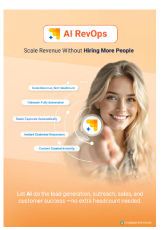RevOps boosts sales productivity by 20% by aligning sales, marketing, and customer success teams. This guide explores challenges and solutions for effective RevOps integration.
Navigating RevOps Challenges: Strategies for Effective Implementation

TL;DR
RevOps is a game-changer for modern businesses, boosting sales productivity by up to 20% through the alignment of sales, marketing, and customer success teams. However, implementing RevOps effectively requires overcoming several challenges. This guide provides practical solutions to these challenges, ensuring seamless integration and enhanced customer experiences.
- Break down data silos with a unified tech stack for seamless data sharing.
- Enhance communication with regular cross-departmental meetings and collaborative tools.
- Develop comprehensive KPIs aligned with RevOps goals.
- Overcome resistance to change with clear communication and training.
- Centralize data management for informed decision-making.
- Leverage automation and AI for strategic initiatives and customer insights.
- Invest in continuous training and feedback loops for team adaptability.
RevOps is essential for staying competitive in the digital age. To explore how AI can transform your revenue operations, check out our AI RevOps solutions. Ready to take the next step? Schedule a demo with us today!
For more information on CloudApper AI RevOps Agent visit our page here.
Are you aware that companies implementing RevOps can boost their sales productivity by up to 20%? In today’s fast-paced business world, RevOps is crucial. It aligns sales, marketing, and customer success teams. This alignment maximizes efficiency and enhances customer experiences. However, achieving seamless RevOps integration comes with challenges. But don’t worry. We’ll explore these challenges and provide practical solutions. This guide will help you implement AI RevOps effectively.
CloudApper AI RevOps breaks down silos between different teams. Everyone works towards common revenue goals. They use shared data and streamlined processes. This approach is essential for modern businesses. But what are the common challenges?
Data silos are a major issue. Different teams use various tools. These tools often don’t communicate with each other. This results in fragmented data and misalignment. To solve this, a unified tech stack is key. Platforms like CloudApper AI RevOps can integrate data across departments. This allows seamless data sharing and collaboration.
Clear communication across departments is another hurdle. Without it, misunderstandings occur. This leads to inefficiencies and lost opportunities. Establishing regular cross-departmental meetings helps. Collaborative tools like Slack or Microsoft Teams can facilitate ongoing communication. This keeps everyone informed and aligned with goals.
Measuring success can be challenging without the right metrics. Many organizations struggle with identifying KPIs that reflect RevOps goals. Developing comprehensive KPIs is essential. These should align with organizational goals and team objectives. Metrics like customer acquisition cost, lifetime value, and conversion rates are valuable.
Resistance to change is common. RevOps often requires cultural shifts. Employees may resist changes, fearing disruption. Leadership must communicate the benefits clearly. Providing training and support is vital. Encouraging adaptability and continuous learning eases transitions.
Centralized data management is crucial. Implementing a centralized CRM ensures all teams access the same data. This fosters collaboration and informed decisions.
Enhanced automation is a cornerstone of RevOps. Automation frees up time for strategic initiatives. AI-driven platforms enhance this with predictive analytics and customer insights.
Continuous training helps employees adapt to new technologies. This boosts skills and morale. Creating feedback loops between teams provides insights into customer needs and trends. Regular feedback sessions identify improvement areas.
Consider Company A, a mid-sized tech firm. They struggled with fragmented systems and misaligned teams. By adopting a RevOps strategy, they increased sales productivity by 15% in a year. Customer satisfaction also improved with enhanced team collaboration.
Looking ahead, RevOps will evolve with AI and machine learning advancements. These technologies provide deeper customer insights. They enable personalized interactions. As remote work grows, cloud-based RevOps solutions are vital for connectivity and collaboration.
RevOps is a powerful framework for aligning teams and driving growth. By tackling challenges like data silos and communication breakdowns, organizations can implement RevOps successfully. Embracing RevOps is essential for companies to stay competitive in the digital age.
To learn more about how AI can transform your revenue operations, explore our AI RevOps solutions. Or, if you’re ready to take the next step, schedule a demo with us today.

Scale Revenue. No Extra Hires
AI Agents that find prospects, nurture leads, engage visitors, close deals & support customers - automatically
How to Implement RevOps in Your Organization
- Assess Your Current State:
Begin by evaluating your current sales, marketing, and customer success processes. Identify areas where teams work in silos. - Integrate Your Tech Stack:
Consider using platforms like CloudApper AI RevOps for a unified tech stack. This integration helps in streamlining data and processes. Read more about automating your sales funnel with AI RevOps. - Foster Cross-Departmental Communication:
Set up regular meetings and choose tools to facilitate communication across teams.
Learn how to enhance communication with AI. - Identify and Standardize KPIs:
Develop KPIs that align with your organization’s goals to effectively measure success. - Promote Change Management:
Implement strategies to handle resistance to change, such as clear communication about the benefits and providing necessary training.
Transform your strategy with AI by understanding resistance to change. - Utilize AI for Enhanced Automation:
Adopt AI-driven platforms for predictive analytics to optimize RevOps processes. Explore AI solutions for RevOps.

Scale Revenue Without Hiring More People
Meet the AI Team Behind Your Revenue Growth
CloudApper’s AI Revenue Operations Team helps you scale without the cost and complexity of hiring.
Learn more | Download BrochureFrequently Asked Questions about RevOps
- What is RevOps?
RevOps, or Revenue Operations, is a strategic approach that aligns sales, marketing, and customer success teams to drive growth and improve customer experiences.
Learn more about AI RevOps. - How does a unified tech stack help with RevOps?
A unified tech stack integrates tools and platforms across departments, enabling seamless data sharing and collaboration among different teams. Discover how to automate your sales funnel. - What are the key challenges in implementing RevOps?
The main challenges include data silos, resistance to change, and communication breakdowns. Explore solutions to overcome these challenges. - How can communication across departments be improved?
Establishing regular cross-departmental meetings and using collaborative tools like Slack or Microsoft Teams can enhance communication.
Read more about revolutionizing revenue operations with AI. - Why might there be resistance to change when implementing RevOps?
Resistance often stems from cultural shifts required by RevOps. Clear communication and comprehensive training can help ease transitions.
Learn how to transform your sales strategy.
AI RevOps Agent
Scale Revenue Without Hiring More People
Download Brochure


Amplifier Agent
Keeps Your Brand Visible With Articles & Social Media Content That Connects.
Learn More
Outreach Agent
Launches Email & SMS Campaigns That Reach Out on Time and Actually Convert.
Learn More


- Works with














Similar Posts

How to Eliminate Bottlenecks in Your Outbound Marketing Process

AI Outreach Agents Boost SaaS Sales Efficiency


 Find Ideal Prospects
Find Ideal Prospects Create Engaging Content
Create Engaging Content Launch Outreach Campaigns
Launch Outreach Campaigns Capture Website Leads
Capture Website Leads Provide Customer Support
Provide Customer Support